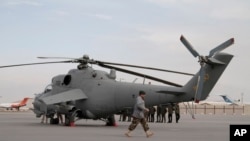Afghanistan has lost most of its air force infrastructure and equipment, including jet fighters and attack helicopters, to several decades of war, including the country’s civil war that broke out in the aftermath of the former Soviet Union’s withdrawal from the country in the late 1980s.
At one time, the country had a powerful air force that could defend its territory, said Major General Abdul Wahab Wardak, commander of the Afghan Air Force.
“Unfortunately, after 1993, the Afghan Air Force was utterly destroyed,” he said, and "we can see its results right now.”
During the civil war, several rival factions gained access to the country’s air defenses and used them for attacks against one another.
And, said Wardak, “Around 20 helicopters and airplanes have been taken out of Afghanistan to the two neighboring countries [Iran and Pakistan].”
Lack of air force
Afghan leaders have long sought warplanes from the international community to help their ground forces in the fight against an insurgency that is spread across the country, making close air support capabilities an absolute necessity for survival.
Since the overthrow of the Taliban in 2001, successive Afghan governments and their international allies have not been in agreement on how to equip Afghan security forces with air fighting mechanisms.
Analysts believe the U.S. and other NATO partners had to consider several variables before providing warplanes because of concerns about accidental use of Afghan airpower against NATO allies spread throughout the country.
Rising causalities
This past year was reported to be the bloodiest for the Afghan National Security Forces (ANSF) since the U.S.-led coalition toppled the Taliban regime and established a new security structure in the country.
“The main reason for increased Afghan security forces casualties is the lack of an effective and sovereign air force,” said Mirdad Nejrabi, chair of the national security committee of the Afghan parliament.
Nejrabi added that Afghan casualties in the war could be drastically reduced with the provision of an effective close air support system owned and managed by Afghans.
Better prospects
That realization was reflected in recent remarks by U.S. Defense Secretary Ash Carter during his trip to eastern Afghanistan’s Nangarhar province, where the Islamic State group has made inroads.
“The U.S. is helping Afghan forces from the air not as much as in the past, but that’s part of the plan, which is to get to the point where Afghans are able to provide for their own air support,” said Carter. “The buildup of the Afghan air forces that’s going on right now, we wish we had started earlier.”
Carter added that over the next year or so, Afghanistan will have its own sovereign air force.
General Wardak told VOA that 2016 is going to be a different year for the ANSF in terms of its casualties.
“Starting in January of 2016, Afghan forces will receive a total of 28 MD 530 F helicopters and around 19 to 25 A-29 airplanes,” he said. “We have several C-130 and C-208 planes at our disposal right now.”
The general added that the MD 530 helicopters would be outfitted with military equipment.
Afghan officials have long complained that the lack of air support for ground forces and medical evacuation helicopters to transport wounded soldiers has contributed to the increase of Afghan casualties on the battlefield.
General Wardak said the new planes coming in 2016 would address most of those problems.











